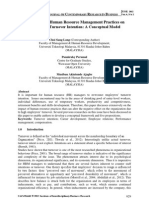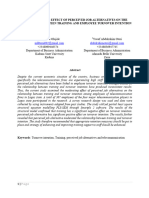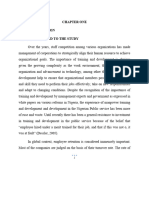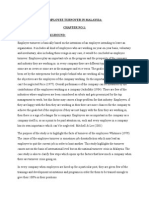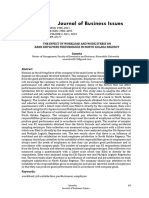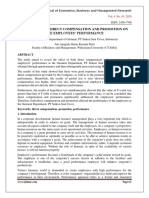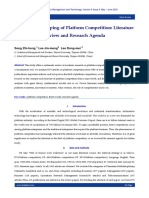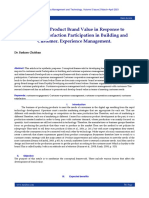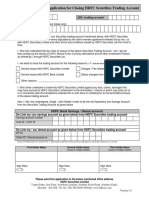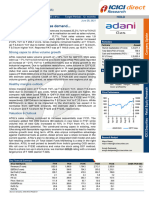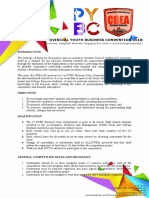Evaluating The Effect of Job Rotation On Employee Retention and Satisfaction: A Case Study of Zambia Telecommunications Company Limited (Zamtel) Finance Department
Evaluating The Effect of Job Rotation On Employee Retention and Satisfaction: A Case Study of Zambia Telecommunications Company Limited (Zamtel) Finance Department
Uploaded by
The IjbmtCopyright:
Available Formats
Evaluating The Effect of Job Rotation On Employee Retention and Satisfaction: A Case Study of Zambia Telecommunications Company Limited (Zamtel) Finance Department
Evaluating The Effect of Job Rotation On Employee Retention and Satisfaction: A Case Study of Zambia Telecommunications Company Limited (Zamtel) Finance Department
Uploaded by
The IjbmtOriginal Title
Copyright
Available Formats
Share this document
Did you find this document useful?
Is this content inappropriate?
Copyright:
Available Formats
Evaluating The Effect of Job Rotation On Employee Retention and Satisfaction: A Case Study of Zambia Telecommunications Company Limited (Zamtel) Finance Department
Evaluating The Effect of Job Rotation On Employee Retention and Satisfaction: A Case Study of Zambia Telecommunications Company Limited (Zamtel) Finance Department
Uploaded by
The IjbmtCopyright:
Available Formats
The International Journal of Business Management and Technology, Volume 4 Issue 4 July – August 2020
ISSN: 2581-3889
Research Article Open Access
Evaluating the Effect of Job Rotation on Employee Retention and
Satisfaction: a Case Study of Zambia Telecommunications
Company Limited (Zamtel) Finance Department
1
Moscane Hampongo, 2Dr David Foya
1MBA Management Strategy
2Senior Lecturer, University of Lusaka, Zambia
Abstract: Management strategists in most organizations are faced with challenges of attracting and retaining top-notch
employees within their organizations. Apart from attractive monetary compensation, leaves, job rotation as a method of
employee retention has least been researched on. Therefore, the use of an effective strategy for the proper management
of job rotation program has great importance and aids in minimizing the negative impacts of circulation. For this
reason,this study sought to evaluate the effectiveness of Job rotation on job satisfaction and job retention at ZAMTEL
Zambia Limited. In pursing this objective, the study utilized a case study approach in seeking to describe the Job
rotation process in place within ZAMTEL’S finance department and ascertaining the effect of Job rotation on employee
satisfaction. Further, Exploratory and descriptive designs, which aimed to look into the effectiveness of job rotation on
the performance of employees, were employed in the study. As a result, an inductive approach was adopted towards
the analysis of the research findings.The study made use of primary and secondary data to facilitate the collecting of
both qualitative and quantitative information on the subject. The study found that the hypothesis that states that the use
of Job rotation results in an increase in employee satisfaction was not statistically significant. Notwithstanding this,
ZAMTEL employees have positive attitude towards the practice of Job rotation. The study found that about 72.5 % of
the respondents support the practice of Job rotation while only 6.0 % registered strong negative attitude towards Job
rotation. The attitude of employees towards Job rotation was not influenced by the employee’s age, marital status, sex
and economic status. However, the case of Zamtel has shown that the relationship of the key variables is not statistically
significant. Notwithstanding that, it was observed that other key variables such as incentives, promotions, longer
employment contracts, independence from government in its operations needed to be explored further to understand
the key contributors to job satisfaction and retention at the company.The study recommended that ZAMTEL should
regularly utilise the practice of job rotation to increase the level of Job satisfaction. The study further recommended that
there was need to incentivize employees at ZAMTEL as they are not deriving satisfaction from job rotation. It was also
recommended that the government should continue to capitalize the company so that it is made more attractive to the
employees to encourage retention in the Finance Department.
Key words: Job rotation, management, Job satisfaction, Job retention, ZAMTEL
I. INTRODUCTION
Today, in organizations, job rotation has become an important issue because it has an impact on job satisfaction and
organizational commitment. Therefore, the use of an effective strategy for the proper management of job rotation
program has great importance. Managers should pay attention to the job circulation problems so as to solve them and
minimize the negative impacts of circulation (Abdullahzadeh, 2007).The benefits of job rotation (transfer and promotion)
from two different points that is from organizational and individual have been analyzed (Jordan and Brauner, 2008).
Organizationally, the transfer of employees from one job to another job results in developing employees' skills.
Managers who change jobs in different parts of the organization they serve gain valuable and practical experience
thereof. Thus, they are prepared for higher positions. As well as transfer and promotion of manpower and employment
www.theijbmt.com 137 | Page
Evaluating the Effect of Job Rotation on Employee Retention and Satisfaction: a Case Study of Zambia…
planning problem is solved. For example, when organizations expand their operations or merged with another
organization it offers Transfer and promotion of staff needed for the new position. Individual aspects of such
organizations benefit from the transfer and promotion. Most managers like to use a professional at a young age and
have an overview of the organization where they work. This allows the transfer and promotion of the opportunity to
obtain a new set of knowledge and competencies. Promotion could mean increases in compensation and benefits for
employees.
According to Bennett (2003), job rotation is a planned replacement of employees among various jobs within a period of
time in order to enhance skills and job independence and results in increasing motivation, job performance and
productivity. Similarly, Gomez, Lorente& Cabrera (2004) define job rotation as the working in varying posts or
situations at time periods which are categorized on a range of individual knowledge, skill and capability of employees.
Jaturanonda, Nanthavanij and Chongphaisal (2006) found that organizations from the private and public sectors
considered the combined ‘knowledge, skills and abilities’ as the predominant decision criterion on who to rotate,
irrespective of the purpose of job rotation. Job rotation or cross training (Ho, Chang, Shih & Liang, 2009) aims to broaden
knowledge, skills and experience by moving people from job to job or department to department (Delpasand, Raiisi,
Begdely&Shahabi, 2010; Lindbeck&Snower, 2000; Olorunsula, 2000). It can be an inefficient and frustrating method of
acquiring additional knowledge and skills unless it is carefully planned and controlled. Job rotation is a systematic
change of employees by transferring them between various areas of responsibility in attempts to enhance employee
experience in the job (Dessler&Varkkey, 2009; Malinski, 2002; Zin, MohdShamsudin&Subramaniam, 2013). In this
regard, Dubois (2000), Williams, Cantillon and Cochrane (2000) and Ebadan and Winstanley (1997) concluded that if
employees value job security, increased lateral moves will be imperative to allow organizational renewal and growth in
the future.
When job rotation is carefully planned and formally developed it has numerous perceived benefits and is particularly
useful in the various industry and work places.
A bored employee can have a substantially negative impact on the level of motivation of other employees. A
demotivated workforce will ultimately result in high absenteeism and employee turnover rates usually accompanied by
poor customer service (Melamed, Ben-Avi, Luz & Green, 1995). Job rotation has been found to relieve boredom and
monotony (USA Today Magazine, 1995). According to Azizi, Zolfaghari& Liang (2009), the most important employee
benefit of differentiation at work is the prevention of monotony. A range of issues including repetitious work causes
boredom and where boredom exists, unproductive behaviours and attitudes such as apathy, disinterest in job,
unhappiness, frustration and escapism and avoidance dominate (Melamed, 1995).
In the provision of mobile telecommunication services, the company faces huge competition from the other players that
include Airtel Networks Zambia Limited (AIRTEL), MTN Zambia Limited (MTN) and the more recent VODAFONE
Zambia LTD which broke into the market in 2016 (VODAFONE, 2018). These and other telecommunication companies
have more recently turned to the provision of Mobile money services. On this frontier, ZAMTEL faces competition from
a mobile money business service called ZAMKWACHA, from Airtel Networks through Airtel Mobile Money and MTN
Zambia through its service called MTN Mobile Money (FSD Zambia, 2018).
The use of job rotation in such a competitive telecommunication industry is cardinal for both productivity gains and
reduced costs due to lower employee turnover. Job rotation can be applied to all departments in the organization and
thus the finance department is not an exception. This is the department that oversees all financial and accounting
services and thus increased productivity due to enhanced job satisfaction can have positive ripple effects throughout the
organization. A standard Finance Department has various sections or units which include Payables, Receivables, Fixed
Assets, Revenue Assurance, Inventory, Treasury and Tax. In summing up, as a profit-making entity, the Finance
Department is a critical organ of ZAMTEL. That being the case, it is important that employees who are found in the
department receive the necessary satisfaction which can be stimulated through rotating them in various jobs within the
department and across branches.
1.1 General Objective
The study evaluated the extent of use and effect of Job rotation on employee satisfaction at ZAMTEL Company Limited.
1.2 Statement of the Problem
www.theijbmt.com 138 | Page
Evaluating the Effect of Job Rotation on Employee Retention and Satisfaction: a Case Study of Zambia…
Job rotation is beneficial to both the organization and employees because employees derive satisfaction from rotating
among jobs. ZAMTEL’s Finance department has had staff strength of 42 workers in different capacities earning in the
range of ZMW 6,000 TO ZMW 60,000. The company has put in place various measures to retain and satisfy the
employees. Among the measures that the company has put in place is the health insurance policy which allows workers
with their family members to access inexpensive health services at selected hospitals and clinics in the location that the
workers are based. Further the company provides advance salary finance facilities for their workers which are easily
accessed when need arises. The company also endeavors to provide a good and clean office environment as a motivation
to the employees at the company. However, despite the different measures that the company has put in place to retain
its employees, every year, about 50 per cent of the employees in the finance department move to other companies in
search for better opportunities. The study intends to evaluate the job rotation system at ZAMTEL and determine the
effectiveness of company’s job rotation practices on employee’s level of Job satisfaction and retention in the Finance
department.
This study, being a case study of ZAMTEL, was restricted to the Finance Department at ZAMTEL head office in Lusaka.
It therefore involved conducting interviews with officials from the Human Resource department at headquarters and
was restricted to the subject of effectiveness of job rotation as a way of satisfying employees. The study can therefore not
be directly applied to other organization and other department since the findings may be unique to ZAMTEL’s finance.
II. FINDINGS
2.1 Job Rotation and Level of Satisfaction
The surveyed employees were asked to rate their level of Job satisfaction and dissatisfaction. The results have been
summarized by figure 1 below:
Figure 1: ZAMTEL employees' level of Job satisfaction and dissatisfaction
Level of Satisfaction Level of Dissatisfaction
Very Satisfied
Not Satisfied 22% Very
30% Dissatisfied
Not 33%
Dissatisfied
45%
Dissatisfied
Satisfied
22%
48%
Source: Computed by Author using sample data
Figure 1 above shows that the majority of the respondents (48%) felt satisfied with job rotation as compared to 22% who
stated that they were dissatisfied. However, those who reported to be very satisfied accounted for only 22% of the
respondents who reported to have been satisfied. Comparatively, among the employees who reported to have been
dissatisfied with their Job, 33% stated that they were very dissatisfied. Generally, therefore, a ZAMTEL employee is
more likely to be satisfied with their Job.
2.2 Relationship between Job Rotation and Job Satisfaction
It has been postulated under hypothesis 𝐻𝑎3 that there is positive relationship between Job rotation and Job Satisfaction.
In order to test the validity of this hypothesis, a chi-square test of association was conducted on employee Job rotation
and Job satisfaction. Table 1 summarized the results.
www.theijbmt.com 139 | Page
Evaluating the Effect of Job Rotation on Employee Retention and Satisfaction: a Case Study of Zambia…
Table 1: Relationship between Job Rotation and Job Satisfaction
Result of Job Rotation Are you Satisfied?
Yes No
More satisfaction from rotation
63.2% 0.0%
Less satisfaction from rotation
Nothing changes
21.1% 100.0%
15.8% 0.0%
ᵪ2 = 3.1588 𝑑𝑓 = 2 𝑝 = 0.206
According to table 1 above, there is no significant relationship between job rotation and one’s level of satisfaction. Thus,
the hypothesis that the more one gets rotated, the more they get satisfied is rejected.
III. DISCUSSION
The research found no evidence of a positive relationship between Job rotation and Job satisfaction as suggested by
Rasouli (2014) and Sweeney (2008). It must be noted however that most empirical studies on Job rotation estimate a
relationship with employee performance and not satisfaction (see KibiyaAjusa et al (2016), Zahra et al (2014) and Rasouli
(2014)). It is apparent that employee satisfaction influenced by numerous factors and more unobservable as compared to
employee performance. According to Saravarni and Abbasi (2013), Job performance is not directly influenced by Job
rotation-it is mediated by Job satisfaction and skill variation. The effect of Job rotation on Job satisfaction may be more
significant when employee performance is used as a proxy of Job satisfaction.
A few studies have found that Job rotation reduced employee motivation and may thus translate into reduce job
satisfaction. These include Eriksson and Ortega (2014) and Mashsan et al. (2012). Eriksson and Ortega (2014) considered
the factors behind the adoption of Job rotation and found no statistical evidence to support the Employee Motivation
Hypothesis. This means there was no evidence that Job rotation positively influence employee motivation. More
definitely, Mashsan et al. (2012) found that Job rotation reduced motivation but increases commitment and employees
involvement. This situation may suggest that the Job rotation practice may be improperly implemented and this causes
worker to be demotivated.
ZAMTEL’s Human resource department has been found to be involved in the implementation of Job rotation through
the provision of motivation such as salary increase, promotion and other incentives. The department also conducts
performance appraisals as employees rotate. This enables the department to determine which role is more suitable for
an employee.
This is in conformity with the application of the Employer Learning Hypothesis. Eriksson and Ortega (2014) found
statistical evidence to support the use of the Employer Learning Hypothesis. Through the employee motivation and
socialization functions, ZAMTEL’s Human resource department applies Maslow’s Needs theory which postulates that
employers can seek to motivate employees by making them more self-actualized, productive and satisfied by meeting
their social needs.
Job rotation at ZAMTEL takes the form of Position rotation which involves literally moving an employee to different
positions, departments or geographic locations for the purpose of developing the employee professionally by exposing
them to new knowledge, skills and perspectives. There is also task rotation which involves moving employees from
highly stressing demanding task to less stressing demanding ones to give them a breather or break.
Employees at ZAMTEL have not been experiencing job satisfaction from job rotation. There has been no relationship
between attitude towards Job Rotation and employees’ age, sex, economic status or marital status. However, there have
been varied levels of dissatisfaction where the older employees are experiencing less dissatisfaction when compared to
the young ones. The human resource department has been conducting training, motivating employees and socializing
them as a way of making them benefit from the rotation process.
IV. CONCLUSION
This research sought to evaluate the effectiveness of Job rotation on job satisfaction and job retention at ZAMTEL
Zambia Limited. In pursing this objective, the study utilized a case study approach in seeking to describe the Job
www.theijbmt.com 140 | Page
Evaluating the Effect of Job Rotation on Employee Retention and Satisfaction: a Case Study of Zambia…
rotation process in place within ZAMTEL’S finance department and ascertaining the effect of Job rotation on employee
satisfaction. The research utilized both quantitative and qualitative technique and collected data using both semi-
structured questionnaires and interview guides. The data was analyzed by generating frequency tables and graphs as
well as using the Chi-square test. Based on the Chi-square test, it has been found that, for the case of ZAMTEL, the
relationship between job rotation and job satisfaction is not statistically significant. The result is supported by some
empirical and theoretical literature. In line with these and other findings, it has been recommended that ZAMTEL and
the Zambian government take advantage of the positive attitude of the employees towards Job rotation and enhance the
effectives of job rotations in order to increase Job satisfaction and retention.Job rotation is in place and contributes to job
satisfaction to a limited extent but not the main mechanism to retain employees. Job dissatisfaction is one of the reasons
why there is high staff turnover but job rotation is not the only contributor to the satisfaction but other variables such as
incentives, promotions, longer employment contracts, independence from government in its operations which need to
be explored further.
V. RECOMMENDATIONS
Based on the findings and above conclusions, the following recommendations are made:
To ZAMTEL Employees: Job rotation is meant to bring about job satisfaction as well as other benefits such as obtaining
various skills. Employees should take advantage of this opportunity that is available to them. The fact that employee
have support for the practice should be able to increase the use of the practice and increase the level of Job satisfaction.
To ZAMTEL Management: There is need to incentivize employees at ZAMTEL as they are not deriving satisfaction
from job rotation. This situation has resulted in increased Job turnover as employees are leaving the company for other
organizations.
To the Government of the Republic of Zambia: ZAMTEL is a parastatal owned by the Zambian government. It is being
recommended that the government continue to capitalize the company so it is made more attractive to the employees to
encourage retention
REFERENCES
[1.] Abdullahzadeh M. (2007). Factors affecting job satisfaction and organizational commitment.MA thesis,
TarbiatModarres University.
[2.] Arshadi N. (2007). Design and test a model of the antecedents and consequences of the motivation In the
employees National Ahvaz oil-rich southern region. PhD thesis, Faculty of Education and Psychology,
University of ShahidChamran.
[3.] Adomi, E.E (2006) Job rotation in Nigerian university libraries. // Library Review, 55, 1, pp. 66-74.
[4.] Barry, G., Harvey, B.M, & Ray, N.O. (1994). Employee Compensation: Theory, Practice, and Evidence. Working
Paper
[5.] Armstrong, M. (1995). A handbook of personnel Management Practices. Kogan Page Limited London.
[6.] Armstrong, Michael. (2001) Human Resource Management Practice. London: Kogan-Page Limited. USA.
[7.] Atkinson and Birch (1978). Introduction to Motivation. New York: D. Van Nostrand Company.
[8.] Atkinson, John; Norman Feather (1974). A Theory of Achievement Motivation (6 ed.). Krieger Pub Co.,
[9.] Beardwell J, and Claydon, T (2007). Human Resource Management: A Contemporary Approach. New York:
Prentice Hall.
[10.] Becker, G.S (1983). Human Capital: A Theoretical and Empirical Analysis with Special Reference to Education.
Cambridge: Mass Ballinger Publishing Company
www.theijbmt.com 141 | Page
Evaluating the Effect of Job Rotation on Employee Retention and Satisfaction: a Case Study of Zambia…
[11.] Birdi, C.; Clegg, C.; Patterson, M.; Robinson, A.; Stride, C.; Wall, T. D. and Wood, S.J. (2008). The Impact of
Human Resource and Operational management Practices on Company Productivity. Personnel Psychology,
61(3), 67-70.
[12.] Booth, S. and Hamer, K. (2007). Labour turnover in the retail industry: Predicting he role of individual,
organisational and environmental factors. International Journal of Retail and Distribution Management. 35(4),
289–307.
[13.] Booyens, S.W. (2000). Dimensions of nursing management. Kenwyn: Juta.
[14.] Bratton J .(1999). Human Resource Management. New York: Lawrence Erlbaum.
[15.] Campion, M. A.; Mumford, T. V.; Morgeson, F. P.; Nahrgang, J. D (2005) Work Redisign: Eight Obstacles and
Opportunities. // Human Resources Management Review, 44, 4, pp. 367-390.
[16.] Carrel, M.R., Elbert, N.F. Hatfield, R.D., Grobler, P.A., Max, M. and Van der Schyf, S. (2000). Human Resource
Management in South Africa. Cape Town: University Press.
[17.] Cederblom, D. (1982). The Performance Appraisal Interview: A Review, Implications, and Suggestions.
Academy of Management Review
[18.] Cohen, A.R. (2000). The Portable MBA in Management. 6th Edition. Nova Scotia: John Wiley and Sons, Inc.
[19.] Cosgel, M. M.; Miceli, T. J (1999). Job Rotation: Cost, Benefits, and Stylized Facts. // Journal of Institutional and
Theoretical Economics, 155, (1999), pp. 301-320.
[20.] Coyne, P.F (2011) An evidence-based model of job rotation (PhD Dissetation). Middlesex University. London,
UK.
[21.] Daniels, A.(2004). Performance Management: Changing Behaviour that Drives Organizational Effectiveness.
New York: SAGE Publications
[22.] Davies, A.; Kirkpatrick, I.; Oliver, N (1992). Merger and Cultural Adjustment: A Report on the UWCC Library
System. Cardiff: Cardiff Business School, 1992.
[23.] DeNisi, A. & Pritchard, R. (2006). Performance Appraisal, Performance Management, and Improving
Individual Performance: A Motivational Framework. Management and Organization Review.
[24.] De Vos, A.S., Strydom, H., Fouche, C.B. and Delport, C. (2007). Research at grass roots. 3rd Edition. Pretoria: Van
Schaik Publishers.
[25.] Del Val, M.P. and Fuentes, C.M. (2003). Resistance to change: A literature review and empirical study.
Management Decision, 41(2), 148–155.
[26.] Dieleman, Marjolein; and others (2006) The Match between Motivation and Performance Management on
Health Sectors in Mali. Bamako: University of Mali.
[27.] Drucker, P (2005) The Practice of Management. London: Elsevier.
[28.] Eguchi, K (2005). Job transfer and influence activities. // Journal of Economic Behavior & Organization, 56,
2(2005), pp. 187-197.
[29.] Erasmus, B., Van Wyk, M. and Schenk, H. (2003). Human Resource Management Theory and Practice. Cape
Town: Juta and Co. Ltd.
[30.] Fægri, T. E.; Dybå, T.; Dingsøyr, T (2010) Introducing knowledge redundancy practice in software
development: Experiences with job rotation in support work. Information and Software Technology, v. 52.
[31.] Falkenburg, K. and Schyns, T. (2007). Work satisfaction, organisational commitment and withdrawal
behaviours. Management Research News, 30 (10), 708–711.
[32.] Gardner, D.G. (2009). Employee Focus of Attention and Reaction to Organisational Change. The Journal of
Applied Behavioural Science, 23(3), 11- 288.
www.theijbmt.com 142 | Page
Evaluating the Effect of Job Rotation on Employee Retention and Satisfaction: a Case Study of Zambia…
[33.] Gomez, P. J.; Lorent, J. J. C.; Cabrera, R. V (2004). Training Practices and Organizational Learning Capability
Relationships and Implications // Journal of European Industrial Training, 28, pp. 234-256.
[34.] Grobler, P.A., Warnich, S., Carrell, M.R., Elbert, N.F. and Hartfield, R.D. (2002). Human Resource Management.
2nd Edition. Cornwall: TJ International.
[35.] Hamermesh, D. (2001). The changing distribution of job satisfaction. Journal of Human Resources, 36 (1), 140–
151.
[36.] Harrison, R. and Kessels, J. (2004). Human Resource Development in a Knowledge Economy: An
Organisational View. New York: MacMillan.
[37.] Heizer, J. and Render, B. (2006). Operations management. 8th Edition. New Jersey: Pearson Prentice Hall.
[38.] Hong J.C, Kuo C.L. (1999). Knowledge management in the learning organization, the leadership &
organization development Journal, 20: 4.
[39.] Herzberg, F., Mausner, B. and Snyderman, B.B. (2002). The motivation to work. 2nd Edition. New York: John
Wiley.
[40.] House, E. R (1980), Evaluating with Validity. California, Beverly Hills: Sage Publications.
[41.] Ichniowski, J. (2004). Human Resource Management in Business Context Employee involvement. Online.
Available at: http://www.hrmguide.co.uk/jobmarket/turnover_cost.htm Date accessed: 11 August 2009.
[42.] Jans, N.; Frazer-Jans, J (2004). Career Development, Job Rotation, and Professional Performance. // Armed
Forces & Society, 30, 2 (2004), pp. 255–277.
[43.] Jorgensen, M.; Davis, K.; Kotowski, S.; Aedla, P.; Dunning, K (2005). Characteristics of Job Rotation in the
Midwest US Manufacturing Sector. // Ergonomics, 48, (2005), pp. 1721-1733.
[44.] Kaymaz, K (2010) .The Effects of Job Rotation Practices on Motivation: A Research on Managers in the
Automotive Organizations. // Business and Economics Research Journal, 1, 3, pp. 69-85.
[45.] Kelly, M.J (1999), The Origin and Development of Education in Zambia. Lusaka: Image Publishers.
[46.] Kombo,D. K and Tromp,D. L. A. (2006) Proposal and Thesis Writing, An Introduction. Nairobi: Paulings
Publications Africa
[47.] Kreitner, R. and Kinicki, A. (2007). Organisationalbehaviour. 7th Edition. New York: McGraw-Hill/Irwin.
[48.] Jordan S, Brauner E. (2008). Job rotation in nursing an esthesio-logical care. 21(2): 114-24.
[49.] Jorgensen M, Davis K, Kotowski S, Aedla P, Dunning K. (2005). Characteristics of job rotation in the midwest
US manufacturing Sector. Ergonomics. 48(15) : 1721-1733.
[50.] Moghimi S. 2001. Organization and management: a research approach. Tehran: Publication of Termeh.
[51.] Naderi A. Naraghi M. (2003).evaluation of research methods in social sciences. Tehran: Badr publication
[52.] Mathis, R.B. and Jackson, J.H. (2007). Human Resource Management. 10th Edition. Singapore: Thomson Asia Pty
Ltd.
[53.] McConnell, R.C. (2004). Managing employee performance. Journal of Health Care Manager, 23 (3), 273–283.
[54.] Muchinsky, P. M. (2006). Psychology Applied to Work (8th ed). Belmont, CA: Thomson Wadsworth.
[55.] Mullins, G.E. (2001). Mergers and Acquisitions: Boon or Bane, Division of Business and Economics. Stevens
Point: University of Wisconsin.
[56.] Mullins, J.L. (2005). Management and OrganisationalBehaviour. 4th Edition. London: Pitman Publishing.
www.theijbmt.com 143 | Page
Evaluating the Effect of Job Rotation on Employee Retention and Satisfaction: a Case Study of Zambia…
[57.] Nel, P.S., Van Dyk, P.S., Haasbroek, G.D., Schulltz, H.B., Sono, T. and Werner, A. (2004). Human Resources
Management. 6th Edition. Cape Town: Oxford University Press.
[58.] Neo, A.R., Hollanbeck, R.J., Gerhart, B. and Wright, P.M. (2006). Human Resource Management. 3rd Edition.
New York: McGraw-Hill.
[59.] Origo, F.; Pagani, L (2008). Workplace Flexibility and Job Satisfaction: Some Evidence From Europe. //
International Journal of Manpower, 29, 1, pp. 42-48.
[60.] Page, N. (2001). Costs of staff turnover. Online. Available at:
http://www.bestbooks.biz/htm/emoloyee_involvement.htm Date accessed: 12 July 2009.
[61.] Paree, U (1997). Training Instrument for HRD. New Delhi: Tata McGraw-Hill
[62.] Park, R.A. (2003). The revolving door of staff turnover. Podiatry Management. Online. Available from:
http://www.findarticles.com/p/articles/mi_mOLMB/IS_2_22/ai_97995746./ Date accessed: 11 June 2009.
[63.] Pfister, U (2012). Globalization. Mainz: Institute of European History.
[64.] Reeves, J (2009). Understanding Motivation and Emotion (5 ed.). Hoboken, NJ: Wiley.
[65.] Richardson, a.; Douglas, m.; Shuttler, r.; Hagland, M.R (2003). Critical care staff rotation: outcomes of a survey
and pilot study. Nursing in Critical Care, 2003.
[66.] Robbins, S.P. (2003). OrganisationalBehaviour: Concepts, Controversies and Applications. 8th Edition. London:
Prentice Hall.
[67.] Robbins, S.P. and Decenzo, D.A. (2001). Fundamentals of Management. 3rd Edition. New Jersey: Prentice-Hall.
[68.] Rossi, P.H & Freeman, H.E (1982), Evaluation: A Systematic Approach, 2nd edn,. Thousand Oaks, California:
Sage Publications.
[69.] Rothwell, Y. and Kazanas, A. (2006). Crafting customer value. New York: Purdue University Press.
[70.] Russell, E. and Bvuma, D. (2001). Alternative service delivery and public service transformation in South
Africa. International Journal of Public Sector Management, 14 (3), 43-55.
[71.] Ryan, Richard; Edward L. Deci (2000). Intrinsic and Extrinsic Motivations: Classic Definitions and New
Directions. New York: Contemporary Educational Psychology.
[72.] Schraeder, M. Becton, J., & Portis, R. (2007, Spring). A Critical Examination of Performance Appraisals. The
Journal for Quality and Participation
[73.] Seeley, Eric (1992) Human Needs and Consumer Economics: an Implication of Maslow’s Theory of Motivation.
Journal for Social Economics.
[74.] Steers, R.M. (2002). Organisational effectiveness: A behavioral view. Santa Monica, CA: Goodyear.
[75.] Stiglitz, J. E. (2002). Globalization and Its Discontents. New York: W.W. Norton.
[76.] Sullivan, J.; Au, S. Developing World Class Job Rotation Programs to Improve Retention, http://www.
drjohnsullivan. com/articles/1998/net25, 1998.
[77.] Swanepoel, B., Erusmus, B., Van Wyk, M. and Schenk, H. (2003). Human Resource Management: Theory and
Practice. 2nd Edition. Cape Town: Juta.
[78.] Tyani, B.I.N. (2001). Absenteeism: A nursing service problem in the Republic of Transkei. Pretoria: UNISA
Press.
[79.] Weerd-Nederholf, P. C., Pacitti, B.J., Da Silva Gomes, J.F. & Pearson , A.W. (2002) Tools for the Improvement of
Organizational Learning Processes in Innovation. Journal of Workplace Learning, 14, 320-331.
www.theijbmt.com 144 | Page
Evaluating the Effect of Job Rotation on Employee Retention and Satisfaction: a Case Study of Zambia…
[80.] Werner, F.B (1984), A Resource-based View of the Firm, Strategic Management Journal, Vol. 5, (April–June): pp.
171-180
[81.] Weiss, C.H (1972), Evaluation Research: Methods for Assessing Program Effectiveness. Englewood Cliffs, New
Jersey: Prentice Hall,
[82.] White, C.J. (2005) Research a Practical Guide. Pretoria: Ithuthuko Investments (Publishing).
[83.] Xie, J. L.; Johns, G (1995). Job Scope and Stress: Can Job Scobe Be Too High. // The Academy of Management
Journal, 38, (1995), pp. 1288-1309.
[84.] ZareDisfany A. (2005). Displacement effect on job satisfaction and organizational commitment of the
management of trade credit, M. Sc., Azad University.
[85.] Zare (2005), D. A. Displacement effect on job satisfaction and organizational commitment in bank credit
management. // Practical Psychology Quarterly, 5, 1(2005), pp. 47-26,
[86.] Ziel, C.B. and Antointette, C.T. (2003). Psychology in the Work Context. 2nd Edition. Cape Town: Oxford
University Press.
[87.] Zaffron, L, D .(2009). Performance Management: The Three Laws of Performance: Rewriting the Future of Your
Organization and Your Life. New York: Prentice Hall
[88.] Zambia Consolidated Copper Mines Investment Holdings (2012) Opportunities of Mining Tax in Zambia.
Kitwe: ZCCM-IH.
[89.] ZAMTEL (2017) 2016 Annual Report. Lusaka: ZAMTEL
Online sources
[90.] www.unicef.org/Zambia
www.theijbmt.com 145 | Page
You might also like
- Assessing Survival Strategies For Agro-Dealers in Chipata and Petauke Districts, Eastern ZambiaDocument6 pagesAssessing Survival Strategies For Agro-Dealers in Chipata and Petauke Districts, Eastern ZambiaThe IjbmtNo ratings yet
- Ralf Reichwald, Rolf T. Wigand - Information, Organization and Management-Springer (2008)Document543 pagesRalf Reichwald, Rolf T. Wigand - Information, Organization and Management-Springer (2008)ryanNo ratings yet
- SWOT Analysis For RevlonDocument1 pageSWOT Analysis For Revlonmuhammadamad8930100% (1)
- Impact of Employee Turnover On Organisational Effectiveness in Tele Communication Sector of PakistanDocument9 pagesImpact of Employee Turnover On Organisational Effectiveness in Tele Communication Sector of PakistanManpreet Kaur VirkNo ratings yet
- P6 - The Impact of Human Resource Management Practices On Employees' Turnover IntentionDocument13 pagesP6 - The Impact of Human Resource Management Practices On Employees' Turnover IntentionI-sha ShahNo ratings yet
- Job Satisfaction and OcbDocument9 pagesJob Satisfaction and OcbLia LianaNo ratings yet
- Human Resource Practices and Employee Retention, Evidences From Banking Sector ofDocument3 pagesHuman Resource Practices and Employee Retention, Evidences From Banking Sector ofAdnanAhmadNo ratings yet
- Seminar WorkDocument20 pagesSeminar WorkanwushijenniferNo ratings yet
- RemunerationDocument11 pagesRemunerationFlorie Ann AguilarNo ratings yet
- Human Resource Management (HRM) Practices On Employee RetentionDocument13 pagesHuman Resource Management (HRM) Practices On Employee RetentionkleinNo ratings yet
- Draft Thesis Document For Addis BekanaDocument81 pagesDraft Thesis Document For Addis BekanaHailu DemekeNo ratings yet
- Mba Thesis Proposal PDFDocument10 pagesMba Thesis Proposal PDFBellaNo ratings yet
- The Implications of Employees Turnover in Nigerian Higher EducationDocument10 pagesThe Implications of Employees Turnover in Nigerian Higher EducationPrince LovetNo ratings yet
- Reward SystemDocument53 pagesReward SystemNininahazwe Oscar67% (3)
- Final Thesis Cha 1&3 (New)Document14 pagesFinal Thesis Cha 1&3 (New)Hikma HamzaNo ratings yet
- 66 PDFDocument3 pages66 PDFMuhammad ArslanNo ratings yet
- 12 Article ReviewDocument3 pages12 Article Reviewgetachew sintayehuNo ratings yet
- RESEARCH METHOD (THE REAL ASSIGNMENT) Pemimpin UpdatedDocument10 pagesRESEARCH METHOD (THE REAL ASSIGNMENT) Pemimpin UpdatedLinda DahlanNo ratings yet
- Intro, Background and Lit ReviewDocument4 pagesIntro, Background and Lit Reviewronica cooreyNo ratings yet
- The Moderating Effect of Perceived Job Alternatives On The Relationship Between Training and Employee Turnover IntentionDocument16 pagesThe Moderating Effect of Perceived Job Alternatives On The Relationship Between Training and Employee Turnover IntentionYasser SayedNo ratings yet
- AbstractDocument10 pagesAbstracttewodrosbayisaNo ratings yet
- Effect of Compensation Strategies On Employee Performance: A Case Study of Mombasa Cement LimitedDocument18 pagesEffect of Compensation Strategies On Employee Performance: A Case Study of Mombasa Cement LimitedelikaNo ratings yet
- Thesis Statement For Employee TurnoverDocument4 pagesThesis Statement For Employee Turnoverdeniseenriquezglendale100% (2)
- Review of Literature For Employee RetentionDocument10 pagesReview of Literature For Employee RetentionnareshNo ratings yet
- The International Journal of Business & ManagementDocument14 pagesThe International Journal of Business & ManagementGevern ChipenziNo ratings yet
- Factors Affecting Employee TurnoverDocument21 pagesFactors Affecting Employee TurnoverchiranrgNo ratings yet
- 4 5769473042375775749Document31 pages4 5769473042375775749fajjiNo ratings yet
- Impact of Training On Employees Performance in Manufacturing IndustriesDocument45 pagesImpact of Training On Employees Performance in Manufacturing IndustriesABDULRAZAQNo ratings yet
- Review This Article PDFDocument27 pagesReview This Article PDFHaliza SaniNo ratings yet
- Mgmt2718 EssayDocument6 pagesMgmt2718 EssayAlison CheungNo ratings yet
- 1268-Article Text-6413-1-2-20211229 (5043)Document26 pages1268-Article Text-6413-1-2-20211229 (5043)Asima IhsanNo ratings yet
- Ijifer M 2 2020Document13 pagesIjifer M 2 2020Vanshika RathoreNo ratings yet
- HR Practices and Readiness For Change Among Malaysian SME's EmployeesDocument10 pagesHR Practices and Readiness For Change Among Malaysian SME's EmployeesmyszeykaNo ratings yet
- Determinants of Labor Turnover in The Bpo Industry Towards The Development of HR Retention ModelDocument8 pagesDeterminants of Labor Turnover in The Bpo Industry Towards The Development of HR Retention ModelKristine BaldovizoNo ratings yet
- Essay MPICDocument6 pagesEssay MPICTom O'BrienNo ratings yet
- How Do Small Business Managers Influence Employee Satisfaction and Commitment?Document14 pagesHow Do Small Business Managers Influence Employee Satisfaction and Commitment?Ahmad RahhalNo ratings yet
- JETIR2110160Document13 pagesJETIR2110160komema3050No ratings yet
- Effects of Benefits On Employee Retention in Private Banking Sector of BangladeshDocument12 pagesEffects of Benefits On Employee Retention in Private Banking Sector of BangladeshShadman SarrarNo ratings yet
- P1930192A - Research Project Proposal - Final 3Document9 pagesP1930192A - Research Project Proposal - Final 3George TwambaNo ratings yet
- Effect of Training On Employee Performance: An Empirical Study On Telecommunication Industry in BangladeshDocument14 pagesEffect of Training On Employee Performance: An Empirical Study On Telecommunication Industry in Bangladeshfareha riazNo ratings yet
- Study of Employee RetentionDocument6 pagesStudy of Employee RetentionDrAmit DuttaNo ratings yet
- The Negative Effect and Consequences of Employee Turnover and Retention On The Organization and Its StaffDocument16 pagesThe Negative Effect and Consequences of Employee Turnover and Retention On The Organization and Its Staffcarlos vazquezNo ratings yet
- Review of Related Literature and Studies: (CITATION Rog16 /L 1033)Document10 pagesReview of Related Literature and Studies: (CITATION Rog16 /L 1033)qwerty100% (1)
- 4186-Article Text-12334-1-10-20241027Document14 pages4186-Article Text-12334-1-10-20241027aliaa.zamriNo ratings yet
- 20220713104727amwebology 18 (6) - 496 PDFDocument25 pages20220713104727amwebology 18 (6) - 496 PDFIsuu JobsNo ratings yet
- Impact of Monetary Incentives On Employees' Performance in Federal Polytechnic NasarawaDocument45 pagesImpact of Monetary Incentives On Employees' Performance in Federal Polytechnic NasarawaChida EzekielNo ratings yet
- READINGDocument19 pagesREADINGLexi BrownNo ratings yet
- Paper 8859Document5 pagesPaper 8859IJARSCT JournalNo ratings yet
- Final Year ThesisDocument34 pagesFinal Year ThesisSyed Usman100% (1)
- Chapter 1-5Document31 pagesChapter 1-5yusufNo ratings yet
- Science and Business: Job Satisfaction of The Employees of Islami Bank Bangladesh LTD: A Study On Lakshmipur DistrictDocument15 pagesScience and Business: Job Satisfaction of The Employees of Islami Bank Bangladesh LTD: A Study On Lakshmipur DistrictTanzia RahmanNo ratings yet
- Workload and Work StressDocument9 pagesWorkload and Work StressHenry DP SinagaNo ratings yet
- Project On Turnover Intentions:-: Submitted To-MS. ESHA SHARMA Bhagra Submitted by - Aman Karanwal (BBA - LLB. 1ST Year)Document6 pagesProject On Turnover Intentions:-: Submitted To-MS. ESHA SHARMA Bhagra Submitted by - Aman Karanwal (BBA - LLB. 1ST Year)Aman KaranwalNo ratings yet
- Sample ODDocument12 pagesSample ODRaiza RamirezNo ratings yet
- Impact of Merger and AcquisitionsDocument12 pagesImpact of Merger and Acquisitionssureshbhatt857No ratings yet
- Ijebmr 498Document12 pagesIjebmr 498irfanhaidersewagNo ratings yet
- The Impact of Employee Empowerment On Employee Satisfaction and Service Quality: Empirical Evidence From Financial Enterprizes in BangladeshDocument12 pagesThe Impact of Employee Empowerment On Employee Satisfaction and Service Quality: Empirical Evidence From Financial Enterprizes in BangladeshJoel D'vasiaNo ratings yet
- rewards-and-organizational-commitment-a-study-among-malaysian-smes-employeesDocument21 pagesrewards-and-organizational-commitment-a-study-among-malaysian-smes-employeesYin ShuangNo ratings yet
- Proposal Development and DissertationDocument8 pagesProposal Development and DissertationhunzakhalidNo ratings yet
- Name: Tran Tuan Anh Student ID: 10190442 Module: Human Resource Management Word CountDocument7 pagesName: Tran Tuan Anh Student ID: 10190442 Module: Human Resource Management Word CountTrần Trung HiếuNo ratings yet
- Essay On Global ManufacturingDocument5 pagesEssay On Global ManufacturingZayyad Musa AbdullahiNo ratings yet
- Model Answer: Literature review on Employee motivation, rewards and performanceFrom EverandModel Answer: Literature review on Employee motivation, rewards and performanceNo ratings yet
- Influence of Devolved Dispute Resolution Mechanisms On Job Satisfaction of Health Care Workers in Nakuru County KenyaDocument13 pagesInfluence of Devolved Dispute Resolution Mechanisms On Job Satisfaction of Health Care Workers in Nakuru County KenyaThe IjbmtNo ratings yet
- Influence of Customer Orientation On The Growth of Manufacturing Firms in Nakuru East and West Sub-Counties KenyaDocument10 pagesInfluence of Customer Orientation On The Growth of Manufacturing Firms in Nakuru East and West Sub-Counties KenyaThe IjbmtNo ratings yet
- Internal Control and Corporate Governance Among CooperativesDocument14 pagesInternal Control and Corporate Governance Among CooperativesThe IjbmtNo ratings yet
- Trip Advisor Resort Online Reviews in Bali. Content Analysis Based On Big DataDocument8 pagesTrip Advisor Resort Online Reviews in Bali. Content Analysis Based On Big DataThe IjbmtNo ratings yet
- Constructing Brand Personality From The TripAdvisor Online ReviewsDocument6 pagesConstructing Brand Personality From The TripAdvisor Online ReviewsThe IjbmtNo ratings yet
- Resiliency of Microenterprises Amidst Pandemic in Davao Del Sur PhilippinesDocument18 pagesResiliency of Microenterprises Amidst Pandemic in Davao Del Sur PhilippinesThe IjbmtNo ratings yet
- Effect of Market Penetration Strategy On Financial Performance of Tobacco Manufacturing Firms in KenyaDocument10 pagesEffect of Market Penetration Strategy On Financial Performance of Tobacco Manufacturing Firms in KenyaThe IjbmtNo ratings yet
- Effect of Net Profit Margin, Debt To Equity Ratio, Current Ratio and Inflation On Dividend Payout RatioDocument10 pagesEffect of Net Profit Margin, Debt To Equity Ratio, Current Ratio and Inflation On Dividend Payout RatioThe IjbmtNo ratings yet
- Topic:Nexus Between Public Sector Employees and Effectiveness of Trade UnionismDocument8 pagesTopic:Nexus Between Public Sector Employees and Effectiveness of Trade UnionismThe IjbmtNo ratings yet
- Evaluation For E-Commerce Using AHP: Designing The ExperimentDocument11 pagesEvaluation For E-Commerce Using AHP: Designing The ExperimentThe IjbmtNo ratings yet
- Knowledge Mapping of Platform Competition: Literature Review and Research AgendaDocument7 pagesKnowledge Mapping of Platform Competition: Literature Review and Research AgendaThe IjbmtNo ratings yet
- The Influence of Youtube Advertising Value On Brand Awareness and Purchase Intentions of Vietnamese CustomersDocument9 pagesThe Influence of Youtube Advertising Value On Brand Awareness and Purchase Intentions of Vietnamese CustomersThe IjbmtNo ratings yet
- Entrepreneurial Intention of The Cotabato City State Polytechnic College (CCSPC) - Bachelor of Science in Business Administration (BSBA) GraduatesDocument10 pagesEntrepreneurial Intention of The Cotabato City State Polytechnic College (CCSPC) - Bachelor of Science in Business Administration (BSBA) GraduatesThe IjbmtNo ratings yet
- Influence of Capacity Building in The Management Reform On Service Delivery at Nakuru Water and Sanitation Services Company (NAWASSCO)Document6 pagesInfluence of Capacity Building in The Management Reform On Service Delivery at Nakuru Water and Sanitation Services Company (NAWASSCO)The IjbmtNo ratings yet
- The Determinants of The Sustainability of Microfinance Institutions Through The Control Systems: Case of Cameroon in Context Covid19Document13 pagesThe Determinants of The Sustainability of Microfinance Institutions Through The Control Systems: Case of Cameroon in Context Covid19The IjbmtNo ratings yet
- Management Innovation and Business Performance of Micro, Small, and Medium Enterprises in Cotabato City During The COVID-19 PandemicDocument9 pagesManagement Innovation and Business Performance of Micro, Small, and Medium Enterprises in Cotabato City During The COVID-19 PandemicThe IjbmtNo ratings yet
- Assessment of Turkey's Innovation Performance During The European Union Candidacy PeriodDocument17 pagesAssessment of Turkey's Innovation Performance During The European Union Candidacy PeriodThe IjbmtNo ratings yet
- Intention and Behavior Towards Bringing Your Own Shopping Bags in Vietnam: An Investigation Using The Theory of Planned BehaviorDocument8 pagesIntention and Behavior Towards Bringing Your Own Shopping Bags in Vietnam: An Investigation Using The Theory of Planned BehaviorThe IjbmtNo ratings yet
- Measures of Tax Compliance Among Small and Medium Enterprises in Tagum City: An Exploratory Factor AnalysisDocument10 pagesMeasures of Tax Compliance Among Small and Medium Enterprises in Tagum City: An Exploratory Factor AnalysisThe IjbmtNo ratings yet
- Developing Product Brand Value in Response To Customer Satisfaction Participation in Building and Customer. Experience ManagementDocument6 pagesDeveloping Product Brand Value in Response To Customer Satisfaction Participation in Building and Customer. Experience ManagementThe IjbmtNo ratings yet
- Influence of Decentralization of Management Reforms On Service Delivery at Nakuru Water and Sanitation Services CompanyDocument5 pagesInfluence of Decentralization of Management Reforms On Service Delivery at Nakuru Water and Sanitation Services CompanyThe IjbmtNo ratings yet
- Factors of Investment Decision Practices Among Certified Public Accountants in Davao Del NorteDocument13 pagesFactors of Investment Decision Practices Among Certified Public Accountants in Davao Del NorteThe IjbmtNo ratings yet
- Factors Affecting University Students' Group Work ResultsDocument12 pagesFactors Affecting University Students' Group Work ResultsThe IjbmtNo ratings yet
- The Effect of Ethical Leadership, Career Distributive Justice On Turnover Intention Through Trust in LeaderDocument10 pagesThe Effect of Ethical Leadership, Career Distributive Justice On Turnover Intention Through Trust in LeaderThe IjbmtNo ratings yet
- Profiling The Risk Tolerance of Higher Education Students in ZambiaDocument10 pagesProfiling The Risk Tolerance of Higher Education Students in ZambiaThe IjbmtNo ratings yet
- Adolescent's Perception of His Influence On Purchase Decision of Mobile Phone For His Own Use: A Consumer Socialization PerspectiveDocument18 pagesAdolescent's Perception of His Influence On Purchase Decision of Mobile Phone For His Own Use: A Consumer Socialization PerspectiveThe IjbmtNo ratings yet
- Identify A Company That Uses The Internet For Marketing, Sales, and Promotions. Answer The Following Questions For The Company of Your ChoiceDocument2 pagesIdentify A Company That Uses The Internet For Marketing, Sales, and Promotions. Answer The Following Questions For The Company of Your ChoiceSebastianAlbertoRodriguezNo ratings yet
- Android Training in NepalDocument2 pagesAndroid Training in NepalDhurba Bahadur BkNo ratings yet
- Closure FormDocument1 pageClosure FormMundlamuri KowshikNo ratings yet
- Section 3 Checklist For BCP AuditDocument5 pagesSection 3 Checklist For BCP AuditCA KRITI CHADHANo ratings yet
- SL. NO Register No NAME Title For The ProjectDocument102 pagesSL. NO Register No NAME Title For The Projectvviji8443No ratings yet
- Kiran Mishra - Project ManagementDocument6 pagesKiran Mishra - Project Management9840414847No ratings yet
- Chapter 8Document22 pagesChapter 8doha safwatNo ratings yet
- Ways of Establishing A Foundation in MalaysiaDocument5 pagesWays of Establishing A Foundation in Malaysiaridz_mohdNo ratings yet
- Sa010-00-1624-Ft-0007 - P2-C - Code 1Document4 pagesSa010-00-1624-Ft-0007 - P2-C - Code 1Kambam MaheswarareddyNo ratings yet
- CTFL-Chapter 1-Introduction v2.2.0Document40 pagesCTFL-Chapter 1-Introduction v2.2.0Ahmad SolihuddinNo ratings yet
- Country Presentation On Cuba: By, Kapish Gaba JKPS/PGDM/10/07Document19 pagesCountry Presentation On Cuba: By, Kapish Gaba JKPS/PGDM/10/07sainiprateek88No ratings yet
- Map Quest%5 B1%5 DDocument31 pagesMap Quest%5 B1%5 DHenry León WongNo ratings yet
- Ikea Sustainability Strategy 2023Document19 pagesIkea Sustainability Strategy 2023canga korporationNo ratings yet
- Adani GasDocument5 pagesAdani Gasal.ramasamyNo ratings yet
- Tally BasicDocument2 pagesTally BasicChandrima DharaNo ratings yet
- The Aperture For Modern CEOs: Aligning Purpose and FocusDocument47 pagesThe Aperture For Modern CEOs: Aligning Purpose and FocusCharlene KronstedtNo ratings yet
- Intensive Writing Meeting 6 Cohesive and CohesionDocument17 pagesIntensive Writing Meeting 6 Cohesive and Cohesionestu kaniraNo ratings yet
- Provincial Youth Business Convention 2018Document4 pagesProvincial Youth Business Convention 2018Cjhay MarcosNo ratings yet
- Background Business Case Key Elements of Organizational Structures Types of Organizational StructuresDocument15 pagesBackground Business Case Key Elements of Organizational Structures Types of Organizational StructuresKaterina Borodacheva100% (1)
- Enhancing The Utility Customer Experience: A Digital FrameworkDocument16 pagesEnhancing The Utility Customer Experience: A Digital FrameworkpokechoNo ratings yet
- ATVWorld Media Kit 2022 - 23Document9 pagesATVWorld Media Kit 2022 - 23NAROO MASKNo ratings yet
- Rfusipil - Umm,+2021+februari Heni 4 CheckDocument8 pagesRfusipil - Umm,+2021+februari Heni 4 CheckSucy Sofiana HidayatNo ratings yet
- Managerial Economics 2Document36 pagesManagerial Economics 2Yogesh GirgirwarNo ratings yet
- Monitor Your Industrial Plant From Anywhere: The World'S #1-Selling Industrial Alarm Notification SoftwareDocument2 pagesMonitor Your Industrial Plant From Anywhere: The World'S #1-Selling Industrial Alarm Notification SoftwareUriel LvNo ratings yet
- Nicholas Piramal PresentationDocument9 pagesNicholas Piramal Presentationshilpa_suresh_7No ratings yet
- Sap BPCDocument8 pagesSap BPCAqueel MohammedaliNo ratings yet
- 66 Specific Training Offerings - by Krest Vbprakashcvmar20Document19 pages66 Specific Training Offerings - by Krest Vbprakashcvmar20Raja GaramNo ratings yet
- Rumi Numeral Symbols: Range: 10E60-10E7FDocument2 pagesRumi Numeral Symbols: Range: 10E60-10E7Fmh7x33No ratings yet




